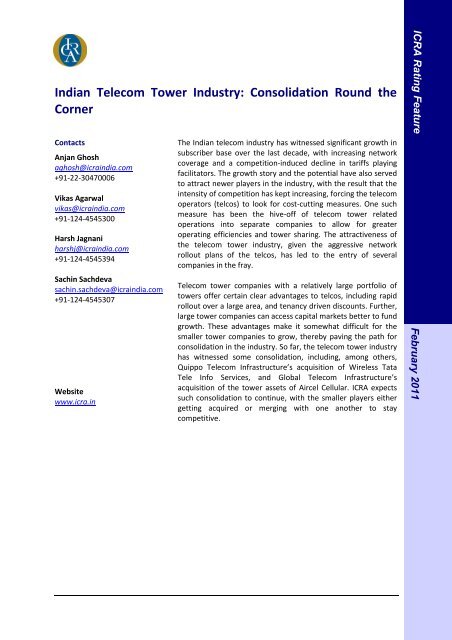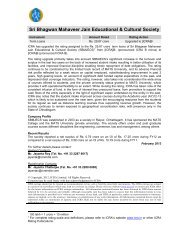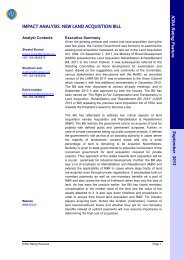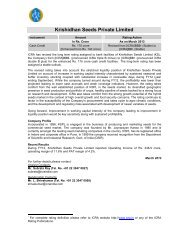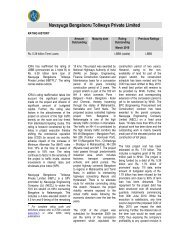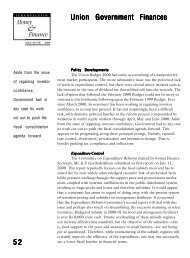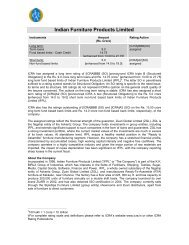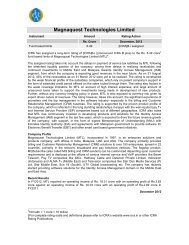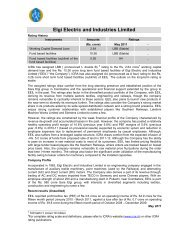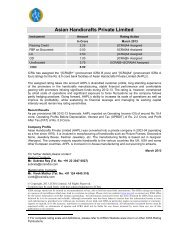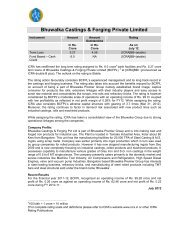Indian Telecom Tower Industry: Consolidation Round the ... - ICRA
Indian Telecom Tower Industry: Consolidation Round the ... - ICRA
Indian Telecom Tower Industry: Consolidation Round the ... - ICRA
You also want an ePaper? Increase the reach of your titles
YUMPU automatically turns print PDFs into web optimized ePapers that Google loves.
<strong>Indian</strong> <strong>Telecom</strong> <strong>Tower</strong> <strong>Industry</strong>: <strong>Consolidation</strong> <strong>Round</strong> <strong>the</strong><br />
Corner<br />
Contacts<br />
Anjan Ghosh<br />
aghosh@icraindia.com<br />
+91-22-30470006<br />
Vikas Agarwal<br />
vikas@icraindia.com<br />
+91-124-4545300<br />
Harsh Jagnani<br />
harshj@icraindia.com<br />
+91-124-4545394<br />
Sachin Sachdeva<br />
sachin.sachdeva@icraindia.com<br />
+91-124-4545307<br />
Website<br />
www.icra.in<br />
The <strong>Indian</strong> telecom industry has witnessed significant growth in<br />
subscriber base over <strong>the</strong> last decade, with increasing network<br />
coverage and a competition-induced decline in tariffs playing<br />
facilitators. The growth story and <strong>the</strong> potential have also served<br />
to attract newer players in <strong>the</strong> industry, with <strong>the</strong> result that <strong>the</strong><br />
intensity of competition has kept increasing, forcing <strong>the</strong> telecom<br />
operators (telcos) to look for cost-cutting measures. One such<br />
measure has been <strong>the</strong> hive-off of telecom tower related<br />
operations into separate companies to allow for greater<br />
operating efficiencies and tower sharing. The attractiveness of<br />
<strong>the</strong> telecom tower industry, given <strong>the</strong> aggressive network<br />
rollout plans of <strong>the</strong> telcos, has led to <strong>the</strong> entry of several<br />
companies in <strong>the</strong> fray.<br />
<strong>Telecom</strong> tower companies with a relatively large portfolio of<br />
towers offer certain clear advantages to telcos, including rapid<br />
rollout over a large area, and tenancy driven discounts. Fur<strong>the</strong>r,<br />
large tower companies can access capital markets better to fund<br />
growth. These advantages make it somewhat difficult for <strong>the</strong><br />
smaller tower companies to grow, <strong>the</strong>reby paving <strong>the</strong> path for<br />
consolidation in <strong>the</strong> industry. So far, <strong>the</strong> telecom tower industry<br />
has witnessed some consolidation, including, among o<strong>the</strong>rs,<br />
Quippo <strong>Telecom</strong> Infrastructure’s acquisition of Wireless Tata<br />
Tele Info Services, and Global <strong>Telecom</strong> Infrastructure’s<br />
acquisition of <strong>the</strong> tower assets of Aircel Cellular. <strong>ICRA</strong> expects<br />
such consolidation to continue, with <strong>the</strong> smaller players ei<strong>the</strong>r<br />
getting acquired or merging with one ano<strong>the</strong>r to stay<br />
competitive.<br />
February 2011<br />
<strong>ICRA</strong> Rating Feature
<strong>Indian</strong> <strong>Telecom</strong> <strong>Tower</strong> <strong>Industry</strong>: <strong>Consolidation</strong> <strong>Round</strong> <strong>the</strong> Corner<br />
1. India among fastest growing mobile markets globally, but also<br />
characterised by intense competition and declining tariffs<br />
<strong>Telecom</strong>munications in India has grown from<br />
a fledgling to a large industry over <strong>the</strong> last<br />
decade, reporting a compounded annual<br />
growth rate (CAGR) of 70% in wireless<br />
subscriber base between March 1999 and<br />
September 2010. During this period, <strong>the</strong> size<br />
of <strong>the</strong> wireless subscriber base has increased<br />
from 0.12 crore to 68.77 crore, taking<br />
wireless teledensity up from 10% to 54%.<br />
The growth in subscriber base has been<br />
facilitated mainly by <strong>the</strong> increase in network<br />
coverage and decline in tariffs and handset<br />
prices. The Government of India’s auction of<br />
2G licences in January 2008 also gave an<br />
impetus to <strong>the</strong> telecom industry’s growth by<br />
providing more spectrum and allowing new<br />
players to enter <strong>the</strong> arena.<br />
With new players coming in, <strong>the</strong> intensity of competition in <strong>the</strong> industry has increased, especially<br />
over <strong>the</strong> last four years, leading to a steep decline in <strong>the</strong> Average Revenue per User (ARPU). This has<br />
been exerting pressure on <strong>the</strong> profitability of <strong>the</strong> telcos. The market shares of <strong>the</strong> telcos, as seen in<br />
Figure 2, reflects <strong>the</strong> fragmented nature of <strong>the</strong> industry, which features as many as 15 players.<br />
Figure 3 brings out <strong>the</strong> pressure on ARPUs for GSM 1 and CDMA 2 operators over <strong>the</strong> last four years.<br />
Figure 2: Market Shares of Telcos (as of Sept 30, 2010) 3 Figure 3: Trend in ARPUs<br />
Source: TRAI Database<br />
Figure 1: Growth in Wireless Subscriber Base in India<br />
Source: <strong>Telecom</strong> Regulatory Authority of India (TRAI)<br />
Database<br />
1 Global System for Mobile Communications<br />
2 Code Division Multiple Access<br />
3 Aircel – Aircel Limited; Bharti – Bharti Airtel Limited; BSNL – Bharat Sanchar Nigam Limited; Etisalat - Etisalat DB <strong>Telecom</strong><br />
India Private Limited; Loop – Loop <strong>Telecom</strong> Limited; MTNL – Mahanagar Telephone Nigam Limited; Reliance – Reliance<br />
Communication Limited including Reliance <strong>Telecom</strong> Limited; Sistema – Sistema Shyam Teleservices Limited; Stel – S Tel<br />
Private Limited; Tata – Tata Teleservices Limited including Tata Teleservices (Maharashtra) Limited; Uninor – Unitech<br />
Wireless Limited; Videocon – Videocon <strong>Telecom</strong>munications Limited; Vodafone – Vodafone Essar Limited; HFCL – HFCL<br />
Infotel Limited<br />
<strong>ICRA</strong> Rating Services Page 2
<strong>Indian</strong> <strong>Telecom</strong> <strong>Tower</strong> <strong>Industry</strong>: <strong>Consolidation</strong> <strong>Round</strong> <strong>the</strong> Corner<br />
2. Emergence of telecom towers as a separate industry<br />
Competitive pressures aside, <strong>the</strong> growth in subscriber base has necessitated expansion of network<br />
coverage, which in turn has driven <strong>the</strong> telcos to make sizeable investments in active and passive<br />
infrastructure. This has added to <strong>the</strong> strain on <strong>the</strong>ir finances, coming on top of profitability pressures<br />
and a larger debt burden. Given this situation, <strong>the</strong> telcos, to reduce costs and focus on <strong>the</strong>ir core<br />
operations, have been hiving off <strong>the</strong>ir tower assets into separate companies (refer annexure on page<br />
9 for functions performed by a tower infrastructure company). This has helped <strong>the</strong> telcos improve<br />
<strong>the</strong>ir capital structure and lower operating expenditure. Moreover, <strong>the</strong> segregation of tower assets<br />
into separate companies has increased <strong>the</strong> prospects of sharing of passive infrastructure and hence<br />
of having an additional revenue stream, <strong>the</strong>reby increasing <strong>the</strong> potential of value-unlocking for <strong>the</strong><br />
telcos. It is against this background that “telecom towers” has emerged as a separate industry during<br />
<strong>the</strong> last few years. Government’s efforts on increasing <strong>the</strong> sharing of passive infrastructure have also<br />
encouraged <strong>the</strong> growth of telecom towers as an industry by itself.<br />
Figure 4: Growth of <strong>Telecom</strong> <strong>Tower</strong> <strong>Industry</strong><br />
Increasing<br />
competition<br />
Source: <strong>ICRA</strong> Research<br />
Pressure on profitability;<br />
increasing debt burden<br />
Over <strong>the</strong> last few years, driven by <strong>the</strong> need for more towers and increasing tower sharing, many<br />
independent telecom tower companies (ITTCs) have also emerged, although <strong>the</strong>se remain much<br />
smaller in relation to <strong>the</strong> telecom operator-owned tower companies.<br />
Figure 5: Ownership of <strong>Tower</strong> Companies<br />
Focus on tower sharing<br />
to reduce costs<br />
1. Telcos-owned <strong>Tower</strong> Companies: This category<br />
consists of companies created by hiving off <strong>the</strong> tower<br />
portfolios of telcos into subsidiaries 4 . Among operatorowned<br />
companies, while most are owned by a single<br />
telco, <strong>the</strong>re is one joint venture, Indus <strong>Tower</strong>s Limited<br />
(ITL), <strong>the</strong> shareholding in which is held by three telcos:<br />
Bharti Airtel Limited, <strong>the</strong> Vodafone group, and <strong>the</strong> Idea<br />
Cellular group. Over 80% of <strong>the</strong> telecom towers in <strong>the</strong><br />
country are owned and managed by telco-owned<br />
companies.<br />
Source: <strong>ICRA</strong> Research<br />
2. Independent <strong>Telecom</strong> <strong>Tower</strong> Companies: This<br />
category consists of companies that are not owned or managed by telcos. These companies build,<br />
own and lease telecom towers to telcos. This is a fragmented segment with a large number of<br />
players. In this segment <strong>the</strong>re are four to five large players, even as <strong>the</strong>re are over 50 players that<br />
are significantly smaller in size than <strong>the</strong> telco-owned tower companies.<br />
4 A few companies (especially BSNL) still own <strong>the</strong> tower assets in <strong>the</strong>ir books.<br />
Segregation of towers<br />
into seperate companies<br />
<strong>ICRA</strong> Rating Services Page 3
<strong>Indian</strong> <strong>Telecom</strong> <strong>Tower</strong> <strong>Industry</strong>: <strong>Consolidation</strong> <strong>Round</strong> <strong>the</strong> Corner<br />
3. Fragmented industry dominated by a few large players<br />
The top six telecom tower companies hold more than 90% of <strong>the</strong> country’s total tower portfolio. The<br />
various tower companies in India along with <strong>the</strong>ir tower portfolios are listed in Table 1.<br />
Table 1: Market Shares of <strong>Telecom</strong> <strong>Tower</strong> Companies (Sep-2010) Figure 6: <strong>Tower</strong> Portfolio (in ’000s)<br />
Players Share<br />
Indus <strong>Tower</strong>s Limited (ITL) 32.2%<br />
Bharat Sanchar Nigam Limited<br />
(BSNL)<br />
15.2%<br />
Reliance Infratel Limited (RITL) 15.2%<br />
Viom Networks Limited (Viom) 11.2%<br />
Bharti Infratel Limited (BIL) 9.7%<br />
GTL Infrastructure Limited (GTL) 9.5%<br />
American <strong>Tower</strong> Company Limited<br />
(ATC)<br />
2.3%<br />
<strong>Tower</strong> Vision India Limited (TVIL) 0.9%<br />
India <strong>Telecom</strong> Infra Limited (ITIL) 0.3%<br />
Aster Infrastructure Limited (Aster) 0.3%<br />
O<strong>the</strong>rs 3.2%<br />
Source: <strong>ICRA</strong> Research and media reports<br />
While <strong>the</strong>re are over 50 independent telecom tower companies in India, most of <strong>the</strong>m have a small<br />
tower portfolio. Never<strong>the</strong>less, <strong>the</strong> small tower companies compensate for <strong>the</strong>ir smaller portfolio by<br />
offering towers concentrated in a particular geography, which makes it easier for <strong>the</strong>m to attract<br />
telcos looking to rollout services in that location.<br />
4. Globally, infrastructure sharing prevalent, but <strong>the</strong>re are no large ITTCs<br />
Globally, tower sharing has emerged as a key growth driver for <strong>the</strong> telecom industry, providing such<br />
benefits as cost reduction, faster rollout, and improvement in asset turnover. However, <strong>the</strong><br />
ownership and management of telecom towers have largely been in <strong>the</strong> hands of telcos.<br />
Never<strong>the</strong>less, <strong>the</strong> telecom tower industry has gained prominence as an independent industry<br />
primarily in two countries, India and <strong>the</strong> USA.<br />
Figure 8: <strong>Telecom</strong> <strong>Tower</strong> <strong>Industry</strong>—International Scenario<br />
USA<br />
India<br />
Europe<br />
China<br />
Africa<br />
Source: <strong>ICRA</strong> Research and media reports<br />
•<strong>Tower</strong>s make seperate industry<br />
•Top two ITTCs hold 30%+ market share<br />
•O<strong>the</strong>r ITTCs growing rapidly<br />
•<strong>Tower</strong>s make separate industry<br />
•Telco-owned tower companies prominent<br />
•Most ITTCs have small tower base<br />
•Cell site sharing common<br />
•Cell sites owned by telcos<br />
•ITTCs emerging<br />
•Cell sites owned by telcos<br />
•Sharing initiated<br />
•ITTCs entering <strong>the</strong> industry<br />
•<strong>Telecom</strong> towers owned by telecos<br />
•Cell site sharing initiated<br />
Sharing<br />
Prevalent,<br />
<strong>Telecom</strong> <strong>Tower</strong><br />
as a Separate<br />
<strong>Industry</strong><br />
<strong>Tower</strong>s<br />
Owned by<br />
Telcos, Sharing<br />
Practised<br />
Towes Owned<br />
by Operators,<br />
Sharing<br />
Initiated<br />
<strong>ICRA</strong> Rating Services Page 4
<strong>Indian</strong> <strong>Telecom</strong> <strong>Tower</strong> <strong>Industry</strong>: <strong>Consolidation</strong> <strong>Round</strong> <strong>the</strong> Corner<br />
The USA and India have witnessed segregation of telecom towers by telcos, who have ei<strong>the</strong>r hived<br />
off <strong>the</strong> towers business into separate entities or sold <strong>the</strong>ir tower assets to a third party, <strong>the</strong>reby<br />
paving <strong>the</strong> path for <strong>the</strong> emergence of telecom towers as a separate industry. Fur<strong>the</strong>r, independent<br />
players have also developed telecom towers, which <strong>the</strong>y lease to <strong>the</strong> telcos. In o<strong>the</strong>r parts of <strong>the</strong><br />
world, cell site sharing is ei<strong>the</strong>r already in practice or has been initiated, but telecom towers are<br />
managed and operated primarily by <strong>the</strong> telcos.<br />
5. Dynamics of tower industry favour large players<br />
The large telecom tower players are at a competitive advantage over <strong>the</strong>ir smaller counterparts,<br />
given <strong>the</strong> capital intensive nature of <strong>the</strong> tower industry, and <strong>the</strong> dynamics of <strong>the</strong> <strong>Indian</strong> telecom<br />
industry, characterised by increasing competition, pressures on profitability, and criticality of timeto-market.<br />
The factors favouring <strong>the</strong> larger players in <strong>the</strong> industry are discussed in <strong>the</strong> following subsections.<br />
Given <strong>the</strong>se factors, <strong>the</strong> smaller players are likely to find it challenging to capture any<br />
significant share of <strong>the</strong> anticipated growth in <strong>the</strong> tower industry, paving <strong>the</strong> way for consolidation.<br />
5.1. Ability to attract larger number of tenants per tower, leading to higher profitability<br />
Figure 9: IRR of <strong>Tower</strong> Companies at Various Tenancy<br />
Ratios<br />
Source: <strong>ICRA</strong> Research<br />
A key factor enabling higher tenancy for a telecom<br />
tower company is growth in its tower portfolio.<br />
<strong>Tower</strong> companies with larger tower portfolios have<br />
been able to command higher tenancy on account<br />
of following factors:<br />
a. Telcos prefer to deal with large tower<br />
companies that offer wider coverage. This helps<br />
<strong>the</strong> telcos avoid dealing with multiple tower<br />
companies (which makes managing network<br />
rollout easier), and also lowers logistics costs.<br />
b. Telcos can benefit from volume discounts that<br />
come with placing orders for a number of<br />
towers with large tower companies.<br />
c. Each incremental tenancy on a given tower<br />
lowers <strong>the</strong> rental for all <strong>the</strong> tenants. Thus large<br />
tower companies with an already high tenancy<br />
are more likely to attract more tenants.<br />
The tower industry is capital intensive and<br />
its profitability is directly related to <strong>the</strong><br />
tenancy ratio (average number of tenants<br />
per tower) as it leads to significant addition<br />
to revenue at a relatively low incremental<br />
cost. According to <strong>ICRA</strong>’s estimates, <strong>the</strong><br />
financial metrics of <strong>the</strong> telecom tower<br />
business improve significantly once <strong>the</strong><br />
tenancy ratio crosses 1.8 times. Assuming an<br />
initial capital expenditure of Rs. 26 lakh (for<br />
ground based tower, or GBT) and a life of 15<br />
years, <strong>the</strong> manner in which <strong>the</strong> IRR moves at<br />
various occupancy levels is depicted in<br />
Figure 9.<br />
Figure 10: Benefits of Large <strong>Tower</strong> Companies<br />
Strong<br />
Financial<br />
Profile<br />
Integrated<br />
Services<br />
Source: <strong>ICRA</strong> Research<br />
Wide<br />
Coverage<br />
Large<br />
<strong>Tower</strong><br />
Companies<br />
Pace of<br />
Execution<br />
Economies<br />
of Scale<br />
<strong>ICRA</strong> Rating Services Page 5
<strong>Indian</strong> <strong>Telecom</strong> <strong>Tower</strong> <strong>Industry</strong>: <strong>Consolidation</strong> <strong>Round</strong> <strong>the</strong> Corner<br />
5.2. Captive tenancy a source of advantage for some large tower companies<br />
The large tower companies by virtue of being owned by one or more telecom operators enjoy <strong>the</strong><br />
Table 3: Telcos and <strong>Tower</strong> Companies<br />
<strong>Telecom</strong> Operator Main <strong>Tower</strong> Company<br />
Bharti BIL/ITL<br />
Reliance RITL<br />
Vodafone ITL<br />
BSNL MTNL, BSNL and O<strong>the</strong>rs<br />
Idea ITL<br />
Tata Viom<br />
Aircel Own and O<strong>the</strong>rs<br />
MTNL BSNL, MTNL and O<strong>the</strong>rs<br />
O<strong>the</strong>rs Own and O<strong>the</strong>rs<br />
Source: <strong>ICRA</strong> Research<br />
benefit of captive tenancy. This is because <strong>the</strong><br />
telcos are expected to give preference to <strong>the</strong>ir<br />
own tower companies when <strong>the</strong>y (<strong>the</strong> telcos) roll<br />
out <strong>the</strong>ir networks (refer Table 3). The smaller<br />
independent telecom tower companies, on <strong>the</strong><br />
o<strong>the</strong>r hand, have no such advantage and for <strong>the</strong>m<br />
<strong>the</strong> scope of business growth is thus lower.<br />
Fur<strong>the</strong>r, given <strong>the</strong> growth plans of <strong>the</strong> telcos, <strong>the</strong><br />
operator-owned telecom tower companies are<br />
likely to be able to grow <strong>the</strong>ir tower portfolios at a<br />
relatively faster pace, fur<strong>the</strong>r widening <strong>the</strong> gap<br />
between <strong>the</strong> large and small players.<br />
5.3. Ability of large tower companies to offer attractive rentals a competitive advantage<br />
Table 2: EBITDA Margins of <strong>Telecom</strong> Operators<br />
Players Mar-08 Mar-09 Mar-10<br />
Bharti Airtel 42% 40% 40%<br />
Reliance 43% 42% 36%<br />
IDEA 36% 31% 26%<br />
TTML 5 27% 29% 24%<br />
Source: Annual Reports of companies<br />
The large tower companies benefit from a wide<br />
portfolio and relatively more established tenancy,<br />
which allows <strong>the</strong>m to offer discounts on rentals,<br />
making <strong>the</strong>m more attractive for telcos. This is<br />
especially true in <strong>the</strong> current scenario in which<br />
telcos, faced with profitability pressures, are seeking<br />
to lower <strong>the</strong>ir costs. Moreover, with <strong>the</strong> launch of<br />
3G services and <strong>the</strong> introduction of mobile number<br />
portability, <strong>the</strong> competitive pressures are likely to increase fur<strong>the</strong>r, and this in turn would bring cost<br />
reduction under sharper focus.<br />
5.4. Seeking faster 3G, BWA network-rollout, telcos likely to favour larger tower players<br />
In May 2010, Government of India completed its<br />
auctions for 3G and broadband wireless access<br />
(BWA) spectrums. The telcos have paid large<br />
fees for acquiring <strong>the</strong>se spectrums, and given<br />
<strong>the</strong> scale of investments, <strong>the</strong> operators now<br />
need to roll out <strong>the</strong> 3G/BWA networks at a rapid<br />
pace. Fur<strong>the</strong>r, <strong>the</strong> fact that 3G spectrum has<br />
been allocated in a higher frequency band of<br />
1800-2100 MHz, <strong>the</strong> requirement of telecom<br />
towers is expected to be high 6 . Thus, <strong>the</strong> telcos<br />
are expected to give preference to large<br />
telecom tower companies to achieve faster<br />
network rollout.<br />
Table 4: Results of 3G Auction<br />
Operator Circles<br />
Amount (Rs.<br />
Cr.)<br />
Bharti Airtel 13 12,295<br />
Aircel 13 6,499<br />
Idea 11 5,769<br />
Reliance 13 8,585<br />
Stel 3 338<br />
Tata 9 5,864<br />
Vodafone 9 11,618<br />
BSNL 20 10,187<br />
MTNL 2 6,564<br />
Total<br />
67,719<br />
Source: Department of <strong>Telecom</strong>munication (DoT)<br />
Database<br />
5 Tata Teleservices Maharashtra Limited<br />
6 The coverage of a telecom tower is determined by <strong>the</strong> Base Transceiver Station (BTS) which contains <strong>the</strong> equipment for<br />
transmitting and receiving radio signals (transceivers), antennas, and equipment for encrypting and decrypting<br />
communication signals. The coverage, in terms of area, of a BTS reduces as <strong>the</strong> frequency band at which it operates<br />
increases. Thus, in order to provide coverage in a given area, <strong>the</strong> number of BTSs required at spectrum of 1800-2100 Mhz<br />
would be higher than <strong>the</strong> number of BTSs required at spectrum of 800 – 900 Mhz<br />
<strong>ICRA</strong> Rating Services Page 6
<strong>Indian</strong> <strong>Telecom</strong> <strong>Tower</strong> <strong>Industry</strong>: <strong>Consolidation</strong> <strong>Round</strong> <strong>the</strong> Corner<br />
5.5. Financially strong players better placed to make <strong>the</strong> required capital expenditure<br />
According to <strong>ICRA</strong>’s estimates, <strong>the</strong> size of <strong>the</strong> total wireless subscriber base in <strong>the</strong> country would<br />
cross 90 crore by March 2013. Given such growth in subscriber base, <strong>the</strong> expected increase in<br />
coverage requirements for <strong>the</strong> rollout of 3G and BWA networks, and <strong>the</strong> scattered distribution of<br />
<strong>the</strong> rural population, significant investments in setting up telecom towers are anticipated over <strong>the</strong><br />
next few years. Besides, capital expenditure would also be required towards maintenance, upgrade<br />
and replacement of existing towers, which will only push up <strong>the</strong> funding requirement.<br />
The capital intensive nature of <strong>the</strong> telecom tower industry is likely to make it challenging for <strong>the</strong><br />
smaller companies to significantly expand <strong>the</strong>ir scale. Thus <strong>the</strong> tower addition anticipated is likely to<br />
be driven mainly by <strong>the</strong> larger players. In this context, <strong>the</strong>ir relatively strong financial position<br />
enables <strong>the</strong>m to ensure faster rollout of new towers, making <strong>the</strong>m more attractive for telcos.<br />
5.6. Large players more likely to make investments in research and development for<br />
reducing energy cost at towers<br />
For a telco, after site rental, <strong>the</strong> next biggest operating expenditure at a tower is <strong>the</strong> power expense<br />
(mainly for air-conditioning and running of equipment). The power requirement of a tower can be<br />
met from ei<strong>the</strong>r of <strong>the</strong> two sources, <strong>the</strong> grid or diesel generator (DG) sets, with <strong>the</strong> latter being more<br />
expensive. As telcos expand into rural areas, availability of grid power may be a constraint, which<br />
would <strong>the</strong>n force <strong>the</strong> towers to rely more on high-cost DG sets. To retain <strong>the</strong>ir own attractiveness<br />
and enable telcos control <strong>the</strong>ir overall operating cost, tower operators would want to bring down<br />
<strong>the</strong> power cost through various means. But this would require investments in research and<br />
development towards exploring alternative means of power generation and/or ways to reduce<br />
power consumption. Such investments are more likely to be undertaken by large players, given <strong>the</strong>ir<br />
relatively strong financial profile. Thus, <strong>the</strong> ability of large players to lower operating costs increases<br />
<strong>the</strong>ir bargaining power and competitive advantage over <strong>the</strong> smaller players.<br />
6. Acquisitions – a possible route for faster tower rollout<br />
The competitive scenario in <strong>the</strong> telecom industry in India has made new customer acquisition<br />
difficult and increased <strong>the</strong> cost of <strong>the</strong> same. This, in addition to <strong>the</strong> high capital expenditure involved<br />
in rolling out services in a new geography, has made time-to-market a critical success factor for<br />
telecom players. There is thus a need for faster rollout of towers in new geographies and for new<br />
services like 3G/BWA. In this context, <strong>the</strong> preference of telcos to deal with larger tower companies,<br />
as discussed earlier, is likely to exert greater pressure on <strong>the</strong>se companies to roll out towers faster.<br />
In some cases, <strong>the</strong> pace at which <strong>the</strong> telcos need to roll out services may outstrip <strong>the</strong> pace at which<br />
towers can be erected by <strong>the</strong> tower companies. Thus, for some tower companies, one of <strong>the</strong><br />
possible ways to expand <strong>the</strong> tower portfolio faster is by acquiring smaller tower companies that<br />
have a presence in small geographical areas.<br />
7. Some level of consolidation has already taken place<br />
The telecom tower industry has exhibited a trend of consolidation over <strong>the</strong> last two years: Quippo<br />
<strong>Telecom</strong> Infrastructure Limited (QTIL) has acquired an equity stake in Wireless TT info Services<br />
Limited (WTTIL; renamed Viom Networks Limited) and merged <strong>the</strong> tower portfolios of <strong>the</strong> two<br />
companies; while GTL and ATC have grown <strong>the</strong>ir tower portfolios through acquisition. Some of <strong>the</strong><br />
key details of <strong>the</strong>se deals are presented in Table 5.<br />
<strong>ICRA</strong> Rating Services Page 7
<strong>Indian</strong> <strong>Telecom</strong> <strong>Tower</strong> <strong>Industry</strong>: <strong>Consolidation</strong> <strong>Round</strong> <strong>the</strong> Corner<br />
Table 5: Merger and Acquisition Deals in <strong>Telecom</strong> <strong>Tower</strong> <strong>Industry</strong><br />
Company Acquirer Valuation<br />
No. of<br />
<strong>Tower</strong>s<br />
Tenancy<br />
(at acquisition)<br />
Valuation<br />
per tower<br />
Date<br />
(Rs. cr.) (Rs. cr.)<br />
WTTIL QTIL 13,000 18,000 1.7x 0.72 Jan 09<br />
Xcel <strong>Telecom</strong><br />
Essar <strong>Telecom</strong><br />
ATC<br />
800-850<br />
2,000<br />
1,700<br />
4,450<br />
1.4x<br />
1.8x<br />
0.47-0.50<br />
0.45<br />
Mar 09<br />
Mar 10<br />
Aircel Cellular Limited GTL 8,500 17,500 - 0.49 Dec 09<br />
Source: <strong>ICRA</strong> Research and media reports<br />
Conclusion<br />
Despite <strong>the</strong> consolidation witnessed in <strong>the</strong> recent past, <strong>the</strong> telecom tower industry in India<br />
continues to be highly fragmented. Going forward, <strong>ICRA</strong> expects <strong>the</strong> trend of consolidation to<br />
continue, with <strong>the</strong> smaller players ei<strong>the</strong>r getting acquired by <strong>the</strong> larger ones or merging with one<br />
ano<strong>the</strong>r to remain competitive. However, <strong>the</strong> pace of consolidation would depend on <strong>the</strong> prevailing<br />
market conditions; pace of infrastructure rollout by <strong>the</strong> telcos, especially for 3G and BWA; and <strong>the</strong><br />
financial flexibility of <strong>the</strong> larger tower companies.<br />
<strong>ICRA</strong> Rating Services Page 8
<strong>Indian</strong> <strong>Telecom</strong> <strong>Tower</strong> <strong>Industry</strong>: <strong>Consolidation</strong> <strong>Round</strong> <strong>the</strong> Corner<br />
Functions of a <strong>Tower</strong> Infrastructure Company<br />
A tower infrastructure company provides passive<br />
infrastructure on a sharing basis to telecom<br />
operators. The role of a tower infrastructure<br />
company may be summarised as follows:<br />
Site acquisition, including entering into longterm<br />
agreements with land owners<br />
Obtaining of necessary regulatory approvals<br />
Erection and commissioning of tower and<br />
allied equipment<br />
Provision of support services such as back-up<br />
power, air-conditioning, and security<br />
Provision of turnkey solutions to telecom<br />
companies such as sourcing of equipment,<br />
testing, and maintenance<br />
Figure 7: Components of a <strong>Telecom</strong> <strong>Tower</strong><br />
Source: <strong>ICRA</strong> Research<br />
Annexure<br />
Types of <strong>Tower</strong>s: <strong>Telecom</strong> towers are broadly classified on <strong>the</strong> basis of <strong>the</strong>ir placement as Groundbased<br />
and Roof-top.<br />
a. Ground-Based <strong>Tower</strong>: Erected on <strong>the</strong> ground, ground-based towers (GBTs) are taller (typically<br />
200 to 400 feet) and are mostly used in rural and semi-urban areas because of <strong>the</strong> easy<br />
availability of real-estate space <strong>the</strong>re. GBTs involve a capital expenditure in <strong>the</strong> range of Rs. 24 to<br />
28 lakh, depending on <strong>the</strong> height of <strong>the</strong> tower.<br />
b. Roof-Top <strong>Tower</strong> (RTT): Roof-top towers (RTTs), which are generally placed on <strong>the</strong> roofs of highrise<br />
buildings, are shorter (than GBTs) and more common in urban and highly populated areas,<br />
where <strong>the</strong>re is paucity of real-estate space. Typically, <strong>the</strong>se involve a capital expenditure of Rs.<br />
15 to 20 lakh.<br />
<strong>ICRA</strong> Rating Services Page 9
<strong>Indian</strong> <strong>Telecom</strong> <strong>Tower</strong> <strong>Industry</strong>: <strong>Consolidation</strong> <strong>Round</strong> <strong>the</strong> Corner<br />
<strong>ICRA</strong> Limited<br />
An Associate of Moody’s Investors Service<br />
CORPORATE OFFICE<br />
Building No. 8, 2 nd Floor, <strong>Tower</strong> A; DLF Cyber City, Phase II; Gurgaon—122002<br />
Tel.: +(91 124) 4545 300; Fax: +(91 124) 4545 350<br />
Email: info@icraindia.com Website: www.icra.in<br />
REGISTERED OFFICE<br />
Kailash Building, 11 th Floor; 26, Kasturba Gandhi Marg; New Delhi—110001<br />
Tel.: +(91 11) 2335 7940-50; Fax: +(91 11) 2335 7014, 2335 5293<br />
Branches: Mumbai: Tel.: + (91 22) 24331046/53/62/74/86/87, Fax: + (91 22) 2433 1390 � Chennai: Tel + (91<br />
44) 2434 0043/9659/8080, 2433 0724/ 3293/3294, Fax + (91 44) 2434 3663 � Kolkata: Tel + (91 33) 2287<br />
0450, 2240 6617/8839, 2280 0008, Fax + (91 33) 2287 0728 � Bangalore: Tel + (91 80) 2559 7401/4049 Fax +<br />
(91 80) 559 4065 � Ahmedabad: Tel + (91 79) 2658 4924/5049/2008, Fax + (91 79) 2658 4924 � Hyderabad:<br />
Tel +(91 40) 2373 5061/7251, Fax + (91 40) 2373 5152 � Pune: Tel + (91 20) 2552 0194/95/96, Fax + (91 20)<br />
2553 9231<br />
© Copyright, 2011, <strong>ICRA</strong> Limited. All Rights Reserved.<br />
Contents may be used freely with due acknowledgement to <strong>ICRA</strong>.<br />
All information contained herein has been obtained by <strong>ICRA</strong> from sources believed by it to be accurate and<br />
reliable. Although reasonable care has been taken to ensure that <strong>the</strong> information herein is true, such<br />
information is provided ‘as is’ without any warranty of any kind, and <strong>ICRA</strong> in particular, makes no<br />
representation or warranty, express or implied, as to <strong>the</strong> accuracy, timeliness or completeness of any such<br />
information. All information contained herein must be construed solely as statements of opinion, and <strong>ICRA</strong><br />
shall not be liable for any losses incurred by users from any use of this publication or its contents.<br />
<strong>ICRA</strong> Rating Services Page 10


